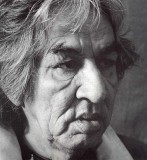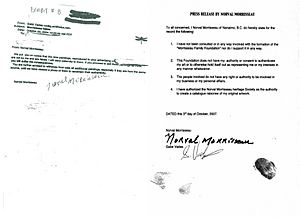Norval Morrisseau facts for kids
Quick facts for kids
Norval Morrisseau
|
|
|---|---|
 |
|
| Born | March 14, 1932 Beardmore, Ontario, Canada
|
| Died | December 4, 2007 (aged 75) Toronto, Ontario, Canada
|
| Education | Self-taught |
| Known for | Painter |
| Movement | Woodlands Style |
| Spouse(s) | Harriet Kakegamic |
| Awards | CM |
Norval Morrisseau CM RCA (March 14, 1932 – December 4, 2007), also known as Copper Thunderbird, was an amazing Indigenous Canadian artist. He was from the Bingwi Neyaashi Anishinaabek First Nation. Many people see him as the founder of modern Indigenous art in Canada.
Morrisseau was called the "Picasso of the North." He created art that showed the old stories of his people. His art also explored the differences between Indigenous and European ways of life. He often painted about his own spiritual journey. His paintings are easy to spot with their thick black outlines and bright, bold colors. He started the Woodlands School of Canadian art. He was also a key member of a group called the “Indian Group of Seven."
Contents
Norval Morrisseau's Early Life
Norval Morrisseau was an Anishinaabe person. He was born on March 14, 1932. His birthplace was the Sand Point Ojibwe reserve near Beardmore, Ontario. His full name was Jean-Baptiste Norman Henry Morrisseau. But he signed his art with his Anishnaabe name, ᐅᓵᐚᐱᐦᑯᐱᓀᐦᓯ (Ozaawaabiko-binesi), which means "Copper/Brass [Thunder]Bird."
Growing Up with Grandparents
Following Anishnaabe traditions, his maternal grandparents raised him. He did not have much contact with his parents. His grandfather, Moses Potan Nanakonagos, was a traditional Medicine Man. He taught Norval the stories and traditions of his people.
His grandmother, Véronique Nanakonagos, was a strong Catholic. From her, he learned about Christianity. These two different spiritual paths greatly shaped his thinking and his art.
School Days and Learning
When he was six, Morrisseau went to a Catholic residential school. It was called St. Joseph’s Indian Residential School in Fort William, Ontario. At this school, students learned European ways. Their native culture was discouraged, and they were not allowed to speak their own language.
After two years, he went back home. He then attended a local community school in Beardmore. Morrisseau left school when he was ten. He preferred to learn from elders instead of staying in formal education. He spent a lot of time listening to elders, drawing, fishing, hunting, and gathering berries.
The Name Copper Thunderbird
At 19, Morrisseau became very ill. Doctors could not help him, and he got worse. His mother called a medicine-woman. She performed a special renaming ceremony. She gave him the new name Copper Thunderbird.
In Anishnaabe tradition, giving a powerful new name to someone who is very sick can bring them new life and energy. After this ceremony, Morrisseau got better. From then on, he always signed his artworks with his new, powerful name.
His Artistic Journey
When Morrisseau first started painting, some people told him not to share traditional stories and images with outsiders. But he decided to break this rule. He believed these stories were important for everyone to see.
Early Challenges and Support
In 1956, Morrisseau got tuberculosis. He went to Fort William Sanatorium to get well. There, he met Harriet Kakegamic, who would become his wife. They had seven children together.
Selwyn Dewdney, an anthropologist, became one of Morrisseau's first supporters. Dewdney was very interested in Morrisseau's deep knowledge of native culture and myths. He helped introduce Morrisseau's art to more people.
Gaining Recognition
Jack Pollock, an art dealer from Toronto, helped Morrisseau's art reach a wider audience in the 1960s. Pollock met Morrisseau in 1962. He was amazed by Morrisseau's talent. He quickly set up an art show for Morrisseau at his gallery in Toronto.
One of Morrisseau's early big projects was a large painting for the Indians of Canada Pavilion at Expo 67. This was an important exhibit that showed the feelings of the First Nations People of Canada about their social and political situation.
Spiritual Changes and Art
In 1972, Morrisseau was in a hotel fire in Vancouver. He was badly burned. During this time, he had a vision that inspired him. He became a Christian and started including Christian ideas in his art.
Later, in 1976, Morrisseau joined the Eckankar movement. This spiritual path focuses on soul travel. He felt that Eckankar's ideas were similar to his traditional Ojibway teachings. He began to show these mystical beliefs in his paintings too.
Founding the Woodland School
Morrisseau started a Canadian art style called Woodland, or sometimes Legend or Medicine painting. His work inspired many younger Ojibwe and Cree artists. These included Blake Debassige and Benjamin Chee Chee.
He grew up in a quiet, isolated area in northern Ontario. This allowed his art style to develop without being influenced by other artists. As the creator of the "Woodland" style, he became an inspiration for three generations of artists.
Awards and Later Life
In 1978, Morrisseau was made a Member of the Order of Canada. This is a very high honor in Canada. He was also a member of the Royal Canadian Academy of Arts.
As he got older, Morrisseau's health declined. He had Parkinson's disease and a stroke in 1994. His adopted family, Gabe and Michelle Vadas, cared for him. In 2005 and 2006, the National Gallery of Canada in Ottawa held a special show of his art. This was the first time the Gallery had a solo exhibition for an Indigenous artist.
In his last months, he used a wheelchair and could not paint. Norval Morrisseau passed away on December 4, 2007, in Toronto. He was buried in Northern Ontario next to his former wife, Harriet.
After his death, a play about his life, Copper Thunderbird, was shown on television. In 2008, he received a special Lifetime Achievement Award.
Norval Morrisseau's Artistic Style
Morrisseau was a self-taught artist. He learned and developed his own unique ways of painting. His art showed ancient legends and images that came to him in visions or dreams.
Early Art and Materials
At first, some people in his community criticized him. They felt he was sharing traditional spiritual knowledge that should be kept secret. He painted on whatever he could find, like birchbark and moose hide. Selwyn Dewdney encouraged him to use natural, earth-tone colors.
His early art focused on the myths and traditions of the Anishnaabe people. He is known for starting the Woodland School of native art. This style uses images similar to the petroglyphs (ancient rock carvings) found in the Great Lakes region. Morrisseau was also inspired by sacred Anishinaabe birch bark scroll images.
Changes in Style and Themes
Later, his style changed. He started using more common art materials. His colors became much brighter, almost like neon lights. The themes of his art also shifted. He began to paint about his own personal challenges.
He also created art with Christian themes. When he was attending a local church, he was impressed by the beautiful images in stained-glass windows. Some of his paintings, like Indian Jesus Christ, show Bible characters with Indigenous features. After joining Eckankar in 1976, he started painting about its mystical beliefs.
Two of Morrisseau's paintings were even featured in the 1980 movie The Shining. These were The Great Earth Mother (1976) and Flock of Loons (1975).
Protecting His Art: Fakes and Forgeries

Norval Morrisseau was very worried about fake artworks being sold. This was especially true in his later years. He worked hard to stop these fakes from being in the art market.
In 2005, Morrisseau created the Norval Morrisseau Heritage Society (NMHS). This group is building a list of all his real paintings. Their goal is to help identify and stop the sale of many fake Morrisseau artworks.
See also
Images for kids
-
On the left, a 2004 email from Norval Morrisseau asking for fake artworks to be removed from sale. On the right, a 2007 press release from Norval Morrisseau saying he had no link with the "Morrisseau Family Foundation." He stated that the Norval Morrisseau Heritage Society was the only group allowed to create a list of his true works.


